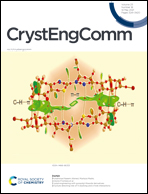Controlled titration-based ZnO formation†
Abstract
Hexamethylenetetramine (HMTA) is commonly used as a base releasing agent for the synthesis of ZnO under mild aqueous conditions. HMTA hydrolysis leads to gradual formation of a base during the reaction. Use of HMTA, however, does have limitations: HMTA hydrolysis yields both formaldehyde and ammonia, it provides no direct control over the ammonia addition rate or the total amount of ammonia added during the reaction, it results in a limited applicable pH range and it dictates the accessible reaction temperatures. To overcome these restrictions, this work presents a direct base titration strategy for ZnO synthesis in which a continuous base addition rate is maintained. Using this highly flexible strategy, wurtzite ZnO can be synthesized at a pH >5.5 using either KOH or ammonia as a base source at various addition rates and reaction pH values. In situ pH measurements suggest a similar reaction mechanism to HMTA-based synthesis, independent of the varied conditions. The type and concentration of the base used for titration affect the reaction product, with ammonia showing evidence of capping behaviour. Optimizing this strategy, we are able to influence and direct the crystal shape and significantly increase the product yield to 74% compared to the ∼13% obtained by the reference HMTA reaction.

- This article is part of the themed collection: Crystal Growth


 Please wait while we load your content...
Please wait while we load your content...